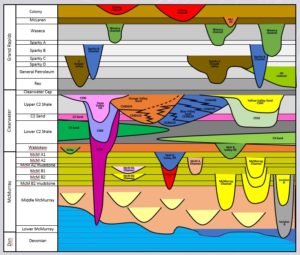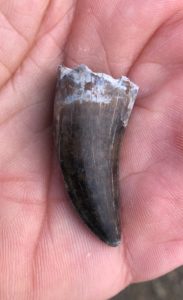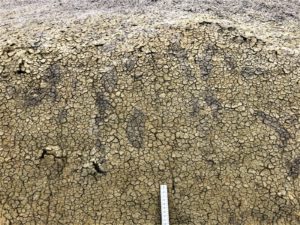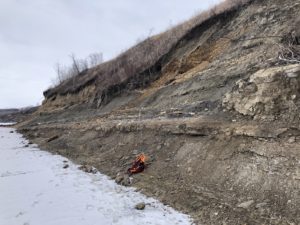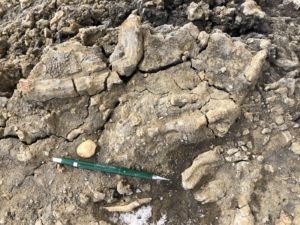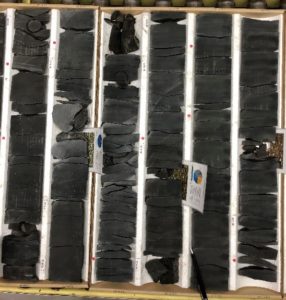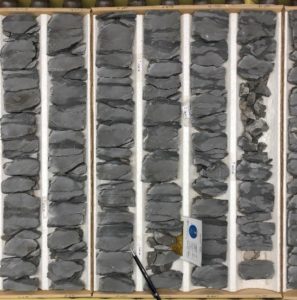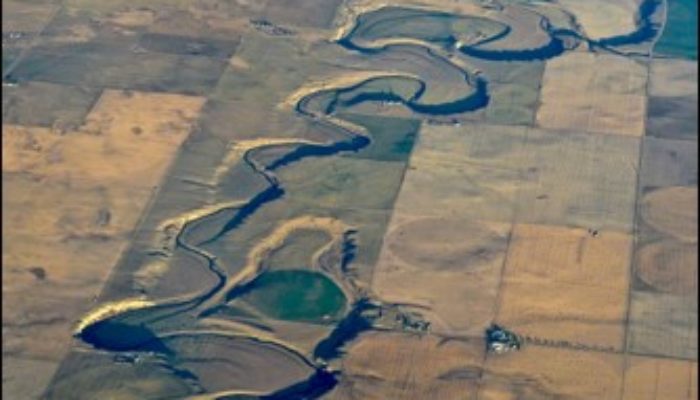
It has been a busy few months here in Calgary. Obviously, fieldwork slows in the winter due to the amount of snow on the ground (and temperatures down to -40 degrees with wind chill factored in) but there are lots of other activities on the go. One of the joys of being a consultant is having the flexibility to take on a wide variety of small projects.
Virtual Presentations
I have found that giving presentations is a great way to broaden your knowledge, focus your research and share your experience, while providing some gentle advertising of your capabilities. I was lucky enough to be invited to speak at the AAPG Super Basins conference in January, with the Western Canada Sedimentary Basin (WCSB) selected as a key basin. I presented on incised valleys of Alberta (see the featured image); there was a vast, interconnected (spaghetti-like) mass of valleys crisscrossing the Province in Albian times, many of which are hydrocarbon bearing.
The fills include the (in)famous oil sands of the McMurray Formation. I looked at how to identify valleys using seismic data, wireline logs and core, examined several diverse case studies and then addressed the “elephant in the room” question as to why these valleys are so common. My theory is that the very shallow gradients, and small receiving basins, in the Lower Cretaceous, magnified any small changes in relative sea level, leading to extensive incision during regressions. The presentation will eventually be available on the AAPG website for free-to-view.
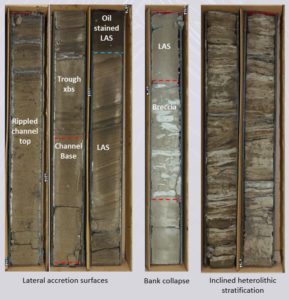 The core photographs show some of the facies encountered in the Cretaceous incised valleys of our Province. They include meandering channel facies in sandy and muddy settings. Obviously the former make better reservoirs.
The core photographs show some of the facies encountered in the Cretaceous incised valleys of our Province. They include meandering channel facies in sandy and muddy settings. Obviously the former make better reservoirs.
A second presentation was for the Royal Tyrrell Museum of Palaeontology. I have been involved in the Speaker Series since 2012 and this year spoke about extraordinary modes of fossil preservation. I divided these up into five themes: layered mudstones lagerstätten; preservation in nodules and cemented intervals; where fossils are encased in unusual media (amber; bitumen, permafrost); and where minerals and finally metals have replaced fossils. Lagerstätten are sites of exceptional fossil preservation, a term coined by Adolf Seilacher in 1970.
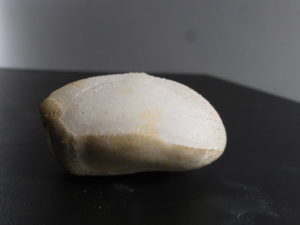 Many amazing fossils were featured including an opalized plesiosaur, a three-dimensional dinosaur preserved in sideritic sandstone and trilobite eggs replaced by pyrite. I also discussed a Pliocene bird nest preserved in travertine, a dinosaur with its internal organs preserved through petrification by calcium phosphate, and mammals recovered from the Siberian permafrost. My favourite “extraordinary fossil”, which I was asked to identify after the talk, is this geopetal Micraster echinoid. The top half is preserved as a perfect glass cast (SiO2), while the basal portion is filled with silica cemented mud that has leaked in through the anus after death.
Many amazing fossils were featured including an opalized plesiosaur, a three-dimensional dinosaur preserved in sideritic sandstone and trilobite eggs replaced by pyrite. I also discussed a Pliocene bird nest preserved in travertine, a dinosaur with its internal organs preserved through petrification by calcium phosphate, and mammals recovered from the Siberian permafrost. My favourite “extraordinary fossil”, which I was asked to identify after the talk, is this geopetal Micraster echinoid. The top half is preserved as a perfect glass cast (SiO2), while the basal portion is filled with silica cemented mud that has leaked in through the anus after death.
A few key themes leapt out while putting the talk together:
- Many key fossils are preserved due to changes in relative sea level (sequence stratigraphy).
- Early cementation has the potential to preserve fossils in three dimensions, with ironstone significantly underrated as a way of preserving fine structures.
- Anoxic conditions also encourage the best preservation for both biological and geochemical reasons.
The talk can be seen (for free) at:
https://www.youtube.com/watch?v=Qv_7tnB2gqU
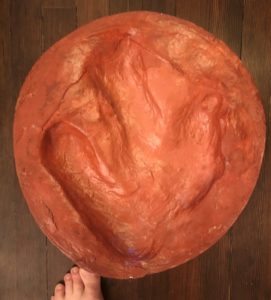 I also gave talks on Dinosaurs to school children as part of the admirable Skype a Scientist program. Some of the children had been on lockdown since March 2020 so hopefully the talks broke up the monotony somewhat. I also (virtually) took my Dinos talk to my daughter’s school. Being virtual allowed me to pull out a bunch of dino fossils to show the kids including a cast of a footprint from Rocky Hill, Connecticut. It is thought to be a Dilophosaurus track.
I also gave talks on Dinosaurs to school children as part of the admirable Skype a Scientist program. Some of the children had been on lockdown since March 2020 so hopefully the talks broke up the monotony somewhat. I also (virtually) took my Dinos talk to my daughter’s school. Being virtual allowed me to pull out a bunch of dino fossils to show the kids including a cast of a footprint from Rocky Hill, Connecticut. It is thought to be a Dilophosaurus track.
Palaeontological fieldwork
Despite the sub-zero temperatures, I have taken on several field projects. The provincial government has approved legislation to ensure that no important fossils are destroyed during excavation work, enabling Consulting Palaeontologists like me (along with other specialists such as archaeologists and biologists) to get involved in a variety of construction projects. Once awarded a contract, the work involves permitting (applying for permission to monitor the sites), free online safety courses and finally fieldwork. In January I visited a proposed drilling site in SE Alberta and logged three sections through the Campanian Oldman Formation (around 76 Ma), as well as collecting fossils that included a nice therapod tooth (photo below right).
The sections represented an interval at the top of the Formation that is eroded further to the North, with abundant shelly hash intervals and a bed rich in crayfish burrows (photo above left).
In March I spent a week in Watino, northern Alberta, undertaking palaeontological monitoring of a bridge remediation project. The outcrops of the Cretaceous Dunvegan Formation, along the banks of the Smoky River, proved to be fully marine, contrary to the published data, with some well preserved trace fossils in an interpreted hardground. There were also some spectacular glacial deposits with thick gravels and rippled sandstone beds, interpreted as outwash channels and plains deposits. One portion of the bank exhibited textbook ice push deformation. It was important to examine the complete succession as there was the potential for mammal remains in the glacial gravels. In the end, the only find of note was a poorly preserved tip of a rostral shark fin spine (Hybodus sp.). I am also working on a late Cretaceous site near Edmonton, Alberta, where a construction company is replacing an elderly pedestrian bridge over Blackmud Creek.
View of outcrop of grey mudstones of the Dunvegan Fm, overlain by glacial gravels. The photo on the right shows Thalassinoides, Planolites, and Rhizocorallium marine traces preserved in a cemented hardground.
Glacial ice push contorting an otherwise flat lying stratigraphic succession of glacial deposits.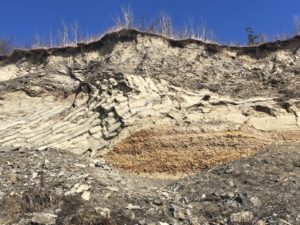
Other field trips
I led my first “private” field trip for a Calgarian musician looking for inspiration and will soon lead a virtual shoreface deposits field trip for another client. I plan to head out to the field later this month to collect new outcrops videos to add to my library, employing a new radio microphone, which dramatically improves sound quality in windy conditions, or when stream flow or traffic noise proves excessive. I also purchased a mini drone and hope to share some footage with you readers soon. Meanwhile some examples of outcrop videos can be viewed at: https://youtu.be/PIsgW6FsBcc
I presented a virtual field trip (VFT) on the Sedimentology of Dinosaur Provincial Park for Seds_Online recently, and will hopefully be showing a Montney VFT for a Chinese client in a few weeks as part of a shale gas course. My virtual field trips were featured in a great article in the March 2021 issue of the AAPG Explorer magazine, but you will need to be able to log in to view the full article: http://Virtual Field Trips Yield Real Life Results (aapg.org)
Other projects
I spent a day in the core store with a University of Alberta PhD. Student collecting samples for geochemical analysis from Duvernay core. The Duvernay Formation is the deepwater equivalent of the Devonian Leduc Reefal reservoirs, and is one of western Canada’s most productive unconventional reservoirs. It comprises packages of laminated, fissile mudstones and brittle (dolomitic) carbonates; the muds act as a Type II marine source rock and the carbonate (where fractured) enhances productivity. The facies exhibit small scale rippling as well as lovely trace and body fossils.
The photos show contrasting facies in the Devonian Duvernay Formation with organic rich mudstone (source rock) on the left and a cemented, fractured carbonate interval on the right.
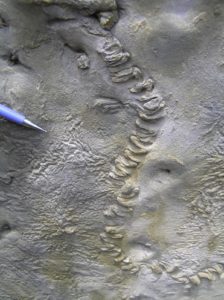 I am working on a paper describing a Miocene bird feeding trace from eastern Borneo. The bird clearly used a scything motion, sweeping its beak back and forth in a style that is previously unreported from the fossil record. I am contributing to a Mississippian sinkholes project. The sinkholes can produce several hundred thousand barrels of oil when located at the junction between two sets of fracture corridors. I was also recently invited to lead two chapters for the proposed 2027 update of the Atlas of the Western Canada Sedimentary Basin: http://Atlas of the Western Canada Sedimentary Basin | Alberta Geological Survey (aer.ca) focusing on “Latest Cretaceous to Palaeogene stratigraphy”, and “Significant Palaeontological Discoveries”.
I am working on a paper describing a Miocene bird feeding trace from eastern Borneo. The bird clearly used a scything motion, sweeping its beak back and forth in a style that is previously unreported from the fossil record. I am contributing to a Mississippian sinkholes project. The sinkholes can produce several hundred thousand barrels of oil when located at the junction between two sets of fracture corridors. I was also recently invited to lead two chapters for the proposed 2027 update of the Atlas of the Western Canada Sedimentary Basin: http://Atlas of the Western Canada Sedimentary Basin | Alberta Geological Survey (aer.ca) focusing on “Latest Cretaceous to Palaeogene stratigraphy”, and “Significant Palaeontological Discoveries”.
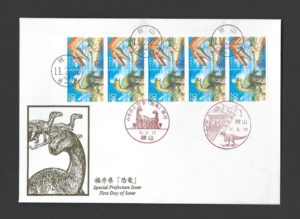 Finally, I presented an exhibit of dinosaurs on stamps illustrating Landmark Dinosaur Discoveries from around the world. The exhibit showcases some of the enormous diversity of Dinosaur related philately. http://Dynamic Dinosaur Discoveries (calgaryphilatelicsociety.com) While not strictly geological, I think that there are not many geologists out there (or indeed anyone else) who can resist the odd dinosaur.
Finally, I presented an exhibit of dinosaurs on stamps illustrating Landmark Dinosaur Discoveries from around the world. The exhibit showcases some of the enormous diversity of Dinosaur related philately. http://Dynamic Dinosaur Discoveries (calgaryphilatelicsociety.com) While not strictly geological, I think that there are not many geologists out there (or indeed anyone else) who can resist the odd dinosaur.
The image shows a Japanese first day cover.

